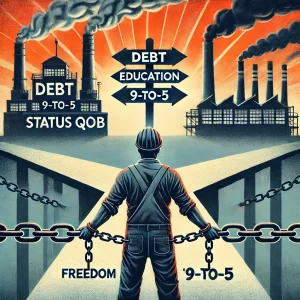
The Middle Class Dilemma
A System Designed to Keep You Trapped
Modern society has perfected a system to maintain economic control over the majority while ensuring the stability of the elite. This system revolves around three critical pillars: the 9-to-5 work culture, a standardized education system, and pervasive debt.
The 9-to-5 Work Trap
Henry Ford’s introduction of the 40-hour workweek in 1914 was revolutionary at the time. It provided workers with consistent hours and better pay, which increased productivity. However, this framework also conditioned people to accept a predictable, limited income in exchange for their time. Today, this model persists, creating a workforce that contributes to economic growth while rarely accumulating personal wealth. The rise of gig jobs, like those offered by Uber and DoorDash, represents an evolution of this model. These jobs often combine the disadvantages of being both a contractor and a traditional employee, offering no benefits, job security, or financial growth potential.
The Education System’s Role
Public education was shaped to produce obedient workers, not free thinkers. Inspired by the Prussian model, the education system teaches conformity, rewards compliance, and conditions students to follow instructions rather than pursue innovation or creativity. This system ensures a steady supply of workers ready to enter the labor force, but it also suppresses critical thinking, which is vital for challenging the status quo.
Debt as a Tool of Control
Debt has become a cornerstone of the middle-class struggle. Mortgages, introduced in the 1930s, and later student loans, were marketed as pathways to success. Instead, they have locked millions into financial obligations that prevent upward mobility. Homeownership, while touted as a hallmark of success, often ties individuals to decades of repayments. Similarly, student loans create lifelong financial burdens, ensuring graduates remain in the workforce, often with limited opportunities to truly get ahead.
The Emerging Threat
The traditional middle-class pathway is further eroded by automation, outsourcing, and economic shifts. Jobs that once provided stability are being replaced by cheaper overseas labor and gig work. The prediction that traditional 9-to-5 jobs may vanish within the next decade paints a grim picture for the future.
Breaking Free: The Need for Independent Thinking
Escaping this system requires reconditioning oneself to think differently. Society has conditioned individuals to believe that success is rare and dependent on luck. In reality, success often comes from playing a different game—one that values creativity, adaptability, and strategic thinking over mere compliance.
To break free, individuals must:
- Explore opportunities that generate income without being tied to hours worked.
- Embrace the concept of risk and experiment with scalable ventures.
- Invest in personal growth and skill development to unlock greater potential.
The Call to Action
As the economy evolves and pressures on the middle class increase, the time to act is now. The next 12 months may be a critical window to build additional income streams, invest in assets, and adapt to new economic realities. By embracing a mindset of innovation and rejecting the constraints of traditional systems, individuals can chart a path to true financial independence.
The key is understanding that the current system isn’t broken; it works exactly as designed. To thrive, you need to step outside it and create a new reality for yourself—one built on independent thinking, strategic decisions, and the courage to take calculated risks.
